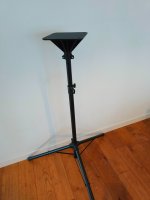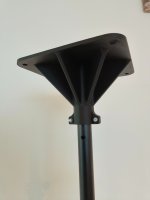That will certainly limit the wiring required. Especially for the turntable. Do you have an arm made up for measuring a horn? or a tweeter?The (wireless) connections need some work. Maybe tomorrow.
Post in thread 'Klippel Near Field Scanner on a Shoestring' https://www.diyaudio.com/community/...d-scanner-on-a-shoestring.318151/post-7754066
That one. I made the holder much more sturdy though.
That one. I made the holder much more sturdy though.
It's moving again!
It's doing a dry run at the moment. Z-motion is reversed somehow and I can find the setting to make it switch. I'm back to the good old A4988 driver iso servo42d for the radial and vertical motion. The ESP32 didn't want to boot properly with the other servo42d. Seems related to
The noise it makes is also far less. For the least amount of noise I need to connect the esp32's to a separate 5V supply and not the fancy ones that take the 20V and put out 5V.
It's doing a dry run at the moment. Z-motion is reversed somehow and I can find the setting to make it switch. I'm back to the good old A4988 driver iso servo42d for the radial and vertical motion. The ESP32 didn't want to boot properly with the other servo42d. Seems related to
When I am in an environment that has nearby walls I generally try to centre the loudspeaker. To get an roughly equal floor ceiling bounce. IN your barn you will have an interesting ability to have pretty much only a floor bounce. The angle of the roof will be quite an effective randomized reflector.
Really like your speaker stand. A smart idea. Not so expensive either. Another intelligent use of available resources Tom.
Really like your speaker stand. A smart idea. Not so expensive either. Another intelligent use of available resources Tom.
I've translated some code from matlab/octave to python using AI and am still testing it. It looks like python(/numpy) automatically does calculations in parallel resulting in a significant speedup. More details will follow once more tests have been written and are successful. A real programming language, a modern IDE with AI integration works like a charm (pun intended). Octave eperience is a bit old and simple, yet somehow I get things done quickly.
For the impatience: https://github.com/TomKamphuys/SphereFactor
I still haven't done the measurements, because of several reasons including a personal tendency towards software.
For the impatience: https://github.com/TomKamphuys/SphereFactor
I still haven't done the measurements, because of several reasons including a personal tendency towards software.

